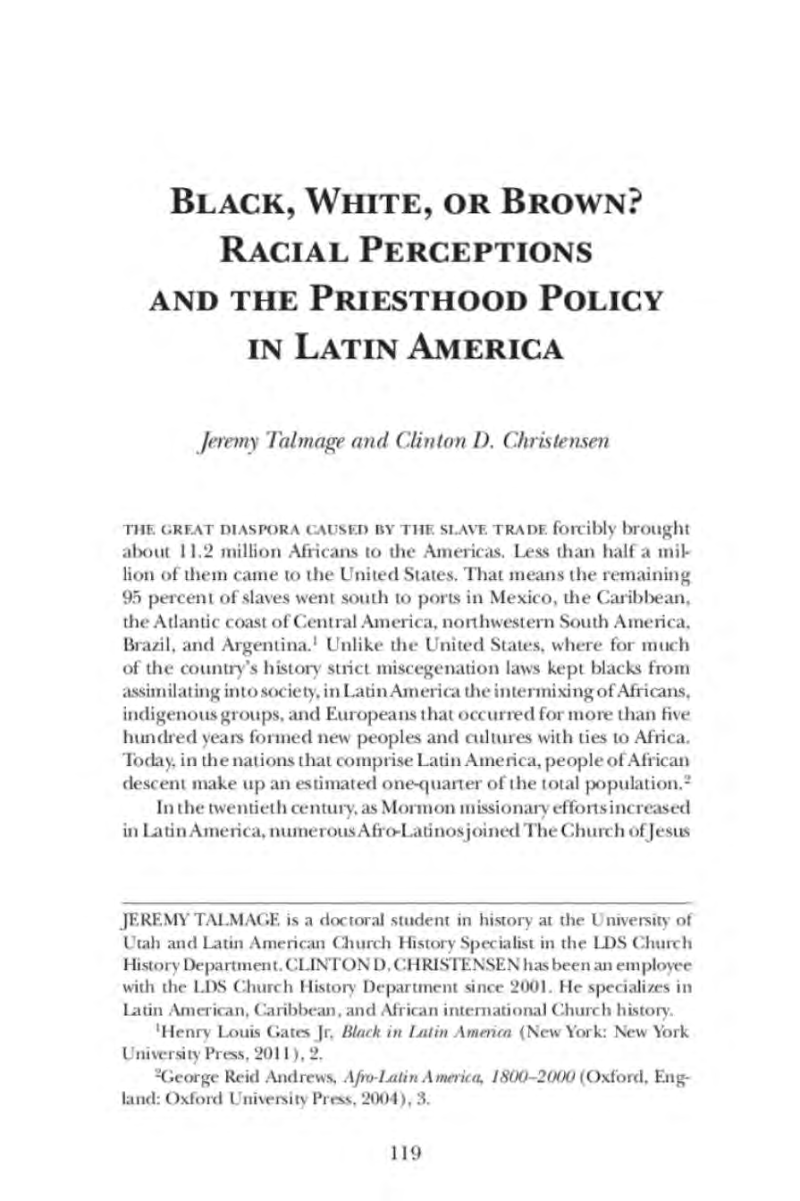Jeremy Talmage and Clinton D. Christensen tell of knowing and unknowing priesthood ordinations of Church members with seeming African heritage.
- Type
- Periodical
- Source
- Jeremy Talmage LDS
- Hearsay
- Direct
- Reference
Jeremy Talmage and Clinton D. Christensen. "Black, white, or brown? Racial perceptions and the priesthood policy in Latin America." Journal of Mormon History 44, no. 1 (2018): 119–45, accessed August 19, 2023
- Scribe/Publisher
- Journal of Mormon History
- Audience
- Reading Public
- Transcription
. . .
When Mormon missionaries arrived in Guayaquil, Ecuador, in 1966, the first thing they did after securing a place to worship was post a notice of their meetings in the local paper. That Sunday, when they arrived to open the building, to their surprise, a man was already waiting outside of the gate. In his hands was a well-used copy of the Book of Mormon. After greeting him, Guillermo Cuesta shared how he first discovered the Church as a young man in the United States. On the cusp of being baptized, family matters had forced him to return to Ecuador. Though not a member, he had patiently waited fro the Church to come to Ecuador and had taught the gospel to his wife and children. The only problem was that Guillermo looked black.
As part of the missionary discussions, the elders presented a special lesson prepared by the mission on the priesthood restriction and shared their concern with Guillermo that he appeared African. Guillermo protested. He was not black, but rather of Lebanese descent. Satisfied by this answer, he was baptized, becoming one of the first members of the Church in Guayaquil. Around the same time, the missionaries came across another promising family while tracting who had initially expressed interest but who quickly became offended after learning about the priesthood restriction. Proud of their African heritage, they refused to join a church that believed something they felt was so wrong. In the process of teaching this family, however, the missionaries learned they were Guillermo's immediate relatives and, at least in the eyes of the elders, undeniably African descendants. By this point, the missionaries had already recommended to their superiors that Guillermo receive the priesthood and be called as a counselor in the branch presidency. As "far and away" the member "best prepared spiritually, intellectually" to take over leadership of the branch, this new information jeopardized that plan. Were the missionaries supposed to trust Guillermo or his family?
In a predicament, the elders asked Apostle Spencer W. Kimball who was visiting Guayaquil to interview Guillermo. On the morning of May 8, 1966, Elder Kimball me with Guillermo at the rented home that served as the church building. After what seemed like an eternity to the missionaries waiting outside, Elder Kimball emerged and told them simply, "I am satisfied that the Lord wants this brother to receive the priesthood." Later that same day in the sacrament meeting, Kimball himself ordained Guillermo a deacon.
Guillermo's ordination never solved the question of whether he was black. Had Elder Kimball exercised his prophetic gift to see in Guillermo's family tree and discern his true ancestry? At least as likely, the missionaries speculated, was the possibility that as an apostle Elder Kimball had received a special dispensation to bestow the priesthood regardless of race. The missionaries, grateful but surprised, struggled to make sense out of the fact that Elder Kimball had ordained a seemingly black man to the priesthood more than twelve years before the priesthood revelation. Since an apostle had personally given Guillermo the priesthood, missionaries and local leaders never questioned the validity of his ordination.
. . .
Only three months later in September 1963, the recent convert [Eduardo Contieri] became the president of the São Paolo Ipiranga Branch. . . . Deciding to set the example by completing his own family history, Eduardo [discovered] . . . "a document that demonstrated I had [African] lineage." . . .
In that moment, Eduardo's self-perception was radically altered. Though to everyone else he looked white, he suddenly identified as black. . . .
Despite the mission president's desire to avoid humiliating Eduardo, his hurried ouster [as branch president] was difficult to hide. . . .
Later, [Elder Spencer W. Kimball] wrote to fellow Apostle Gordon B. Hinckley about Eduardo in 1969. He penned,
Dear Gordon: On May 1, 1966, when we organized the Sao Paulo Stake [sic], there came to my attention the fact that one of our most faithful members possibly was negroid . . .Brother Contieri's story is interesting and faith promoting and heart breaking as are most of the others. After he found that he was negroid, he seems to have accepted the case without bitterness. . . . Inasmuch as that is your area now, I thought you would want to know about Brother Contieri.
. . .
The B. H. Roberts Foundation is not owned by, operated by, or affiliated with the Church of Jesus Christ of Latter-day Saints.

